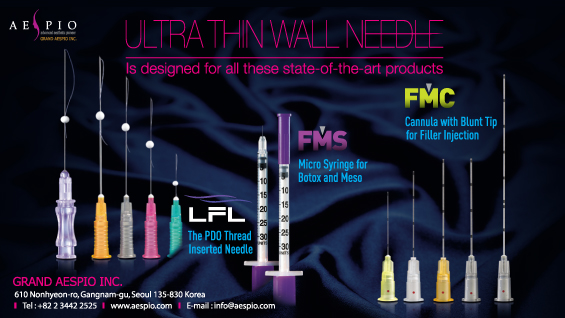Review Article
* Acceptable secondary publication
* This article was published in the Medical Lasers.
* The authors have received approval from the editors of the Medical Lasers and the D&PS.
In the previous article, we provided a systematic literature review of studies on laser toning-induced hypopigmentation or dyspigmentation(LTID).1 Several literatures reported of mottled hypopigmentation occurring after laser toning (LT) therapy.2-6 Because they emphasized the risk of LT treatment and claimed that the incidence of hypopigmentation caused by LT was found to be about 10% in Asians, there were excessive concerns regarding LTID. However, in the last article, we discussed that such concerns are unnecessary as the new treatment techniques and parameters in LT are much safer and require only reasonable caution on the part of the doctor.1
In this article, we would like to examine the pathophysiology of LTID based on histological findings. Moreover, we will also discuss the treatment options that can be offered to patients with hypopigmentation (dyspigmentation) caused by LT.
1. Histopathologic findings of melasma and laser toning outcomes
Before we move on to our main topic, let us help the readers’ understanding by briefly discussing histopathological characteristics of melasma and the principles of LT. As in-depth discussions on this topic could fill a review article, we will keep our discussion brief.
Among many papers on histomorphologic and immunohistochemical characteristics of melasma, there are a few important studies that are most frequently cited.7-12 They have in common a report of melanin increase in all epidermal layers, basal hyperpigmentation, solar elastosis, and epidermal flattening.13 However, they disagree over immunohistochemistry of melanocytes. Some reported the number of melanocytes was increased in the melasma lesion,7-9 whereas others found hyperfunction of melanocytes without a significant increase in the number.10-12 Other noticeable findings are as follows: melanocytes in melasma lesions are larger and have more pronounced dendrites than those in the normal skin;7,10-12 melanocytes protrude into the dermis (pendulous melanocytes) due to damaged basement membrane.14,15 In addition, other noteworthy findings include dermal environmental changes such as evidence of ultraviolet(UV)-induced skin damage, increased inflammatory cytokines, and increased expression of melanogenesis-associated proteins. Dermal inflammation induced from chronic UV irradiation activates fibroblasts, leading to increased dermal stem cell factors and other cytokines stimulating melanogenesis.16 UV irradiation also activates matrix metalloproteinases which in turn damages the basement membrane.15 For these reasons, it was suggested that improving the altered dermal environment of the melasma lesion can correct aberrant signals between dermis and epidermis. Various long-pulsed lasers including the 1,064 nm long-pulsed neodymium-doped yttrium aluminum garnet (Nd:YAG) laser have also been used to treat melasma for skin rejuvenation and improvement of abnormal dermal environment, not for removal of melanin pigments.17,18
In 2011, the structural modifications of melanocytes and melanosomes after LT were reported by Mun et al. 19 who had published a study presenting the theory of ‘subcellular selective photothermolysis’ as theoretical principles of LT. 20 They used transmission electron microscopy, 3VIEW surface block face-scanning electron microscopy and 3D structure reconstruction to allow an in-depth analysis of changes in melanocytes and melanosomes after LT treatment19. As for melanosomes, their number (especially, stage IV melanosomes) significantly decreased and the structure was changed after the treatment. As for melanocytes, they were not destroyed but were reduced in volume and the number of dendrites.19 This study clearly explained the mechanism of LT in melasma and had an impact on following histopathological studies on LT.
[Advertisement] ULTRA THIN WALL NEEDLE – Manufacturer: AESPIO(www.aespio.com)
Kim et al.21 reported similar results in 2013. In addition, they found that LT treatment could down-regulate the expression of tyrosinase-related protein (TRP)-1, TRP-2, nerve growth factors, α-melanocyte-stimulating hormones, tyrosinase, and stem cell factors in melasma lesions.21 This investigation into the mechanism of LT also showed that LT in melasma removed melanosomes and damaged the dendrites of melanocytes without killing the cells, as well as down-regulated the expression of melanogenic proteins. Moreover, some authors pointed out that beyond the actions in melanin fragmentation and dispersion in the epidermis, LT might also promote destruction and migration of dermal melanophages to result in lightening effects.3 It may be due to the effect of LT on promoting lymphatic excretion of melanophages.
Reference
1. Park YW, Yeo UC. Mottled hypopigmentation from laser toning in the treatment of melasma: a catastrophic or manageable complication? Med Lasers 2015;4:45-50.
2. Chan NP, Ho SG, Shek SY, Yeung CK, Chan HH. A case series of facial depigmentation associated with low fluence Q-switched 1,064 nm Nd:YAG laser for skin rejuvenation and melasma. Lasers Surg Med 2010;42:712-9.
3. Polnikorn N. Treatment of refractory dermal melasma with the MedLite C6 Q-switched Nd:YAG laser: two case reports. J Cosmet Laser Ther 2008;10:167-73.
4. Wattanakrai P, Mornchan R, Eimpunth S. Low-fluence Q-switched neodymium-doped yttrium aluminum garnet (1,064 nm) laser for the treatment of facial melasma in Asians. Dermatol Surg 2010;36:76-87.
5. Cho SB, Kim JS, Kim MJ. Melasma treatment in Korean women using a 1064-nm Q-switched Nd:YAG laser with low pulse energy. Clin Exp Dermatol 2009;34:e847-50.
6. Kim MJ, Kim JS, Cho SB. Punctate leucoderma after melasma treatment using 1064-nm Q-switched Nd:YAG laser with low pulse energy. J Eur Acad Dermatol Venereol 2009;23:960-2.
7. Kang WH, Yoon KH, Lee ES, Kim J, Lee KB, Yim H, et al. Melasma: histopathological characteristics in 56 Korean patients. Br J Dermatol 2002;146:228-37.
8. Sanchez NP, Pathak MA, Sato S, Fitzpatrick TB, Sanchez JL, Mihm MC, Jr. Melasma: a clinical, light microscopic, ultrastructural, and immunofluorescence study. J Am Acad Dermatol 1981;4:698-710.
9. Sarvjot V, Sharma S, Mishra S, Singh A. Melasma: a clinicopathological study of 43 cases. Indian J Pathol Microbiol 2009;52:357-9.
10. Grimes PE, Yamada N, Bhawan J. Light microscopic, immunohistochemical, and ultrastructural alterations in patients with melasma. Am J Dermatophathol 2005;27:96-101.
11. Miot LD, Miot HA, Polettini J, Silva MG, Marques ME. Morphologic changes and the expression of alpha-melanocyte stimulating hormone and melanocortin-1 receptor in melasma lesions: a comparative study. Am J Dermatophathol 2010;32:676-82.
12. Miot LD, Miot HA, M.G. S, Marques MA. Estudo comparativo morfofuncional em lesoes de melasma. An Bras Dermatol 2007;82:529-34.
13. Ritter CG, Fiss DV, Borges da Costa JA, de Carvalho RR, Bauermann G, Cestari TF. Extra-facial melasma: clinical, histopathological, and immunohistochemical case-control study. J Eur Acad Dermatol Venereol 2013;27:1088-94.
14. Torres-Alvarez B, Mesa-Garza IG, Castanedo-Cazares JP, Fuentes-Ahumada C, Oros-Ovalle C, Navarrete-Solis J, et al. Histochemical and immunohistochemical study in melasma: evidence of damage in the basal membrane. Am J Dermatophathol 2011;33:291-5.
15. Lee DJ, Park KC, Ortonne JP, Kang HY. Pendulous melanocytes: a characteristic feature of melasma and how it may occur. Br J Dermatol 2012;166:684-6.
16. Kang HY, Hwang JS, Lee JY, Ahn JH, Kim JY, Lee ES, et al. The dermal stem cell factor and c-kit are overexpressed in melasma. Br J Dermatol 2006;154:1094-9.
17. Kang H, Kim J, Goo B. The dual toning technique for melasma treatment with the 1064 nm Nd: YAG laser: A preliminary study. Laser Ther 2011;20:189-94.
18. Choi CP, Yim SM, Seo SH, Ahn HH, Kye YC, Choi JE. Retrospective analysis of melasma treatment using a dual mode of low-fluence Q-switched and long-pulse Nd:YAG laser vs. low-fluence Q-switched Nd:YAG laser monotherapy. J Cosmet Laser Ther 2015;17:2-8.
19. Mun JY, Jeong SY, Kim JH, Han SS, Kim IH. A low fluence Q-switched Nd:YAG laser modifies the 3D structure of melanocyte and ultrastructure of melanosome by subcellular-selective photothermolysis. J Electron Microsc (Tokyo) 2011;60:11-8.
20. Kim JH, Kim H, Park HC, Kim IH. Subcellular selective photothermolysis of melanosomes in adult zebrafish skin following 1064-nm Q-switched Nd:YAG laser irradiation. J Invest Dermatol 2010;130:2333-5.
-To be continued






















